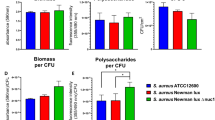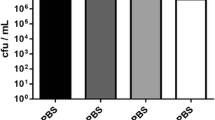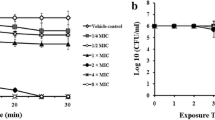Abstract
Staphylococcus epidermidis is now amongst the most important pathogenic agents responsible for bloodstream nosocomial infections and for biofilm formation on indwelling medical devices. Its increasing resistance to common antibiotics is a challenge for the development of new antimicrobial agents. Accordingly, the goal of this study was to evaluate the effect of farnesol, a natural sesquiterpenoid, on Staphylococcus epidermidis planktonic and biofilm cells. Farnesol displayed a significant inhibitory effect on planktonic cells. Small concentrations (100 μM) were sufficient to exhibit antibacterial effect on these cells. In biofilm cells the effect of farnesol was not so pronounced and it seems to be strongly dependent on the cells metabolic activity and amount of matrix. Interestingly, the effect of farnesol at 200 μM was similar to the effect of vancomycin at peak serum concentration either in planktonic or biofilm cells. Overall, the results indicate a potential antibacterial effect of farnesol against S. epidermidis, and therefore the possible action of this molecule on the prevention of S. epidermidis related infections.



Similar content being viewed by others
References
Brehm-Stecher BF, Johnson EA (2003) Sensitization of Staphylococcus aureus and Escherichia coli to antibiotics by the sesquiterpenoids nerolidol, farnesol, bisabolol, and apritone. Antimicrobial Agents Chemother 47:3357–3360
Cerca N, Pier GB, Oliveira R et al (2004) Comparative evaluation of coagulase-negative staphylococci (CoNS) adherence to acrylic by a static method and a parallel-plate flow dynamic method. Res Microbiol 155:755–760
Cerca N, Martins S, Cerca F et al (2005) Comparative assessment of antibiotic susceptibility of coagulase-negative staphylococci in biofilm versus planktonic culture as assessed by bacterial enumeration or rapid XTT colorimetry. J Antimicrob Chemother 56:331–336
Inoue Y, Shiraishi A, Hada T et al (2004) The antibacterial effects of terpene alcohols on Staphylococcus aureus and their mode of action. FEMS Microbiol Lett 237:325–331
Izano EA, Sadovskaya I, Vinogradov E et al (2007) Poly-N-acetylglucosamine mediates biofilm formation and antibiotic resistance in Actinobacillus pleuropneumoniae. Microb Pathog 43:1–9
Jabra-Rizk MA, Meiller TF, James CE et al (2006) Effect of farnesol on Staphylococcus aureus biofilm formation and antimicrobial susceptibility. Antimicrob Agents Chemother 50:1463–1469
Keren I, Kaldalu N, Spoering A et al (2003) Persister cells and tolerance to antimicrobials. FEMS Microbiol Lett 230:13–18
Kuhn DR, Balkis M, Chandra J et al (2003) Uses and limitations of the XTT assay in studies of Candida growth and metabolism. J Clin Microbiol 41:506–508
Lewis K (2007) Persister cells, dormancy and infectious disease. Nat Rev Microbiol 5:48–56
Oliveira M, Nunes SF, Carneiro C et al (2007) Time course of biofilm formation by Staphylococcus aureus and Staphylococcus epidermidis mastitis isolates. Vet Microbiol 124:187–191
Rupp ME, Ulphani JS, Fey PD et al (1999) Characterization of the importance of polysaccharide intercellular adhesin/hemagglutinin of Staphylococcus epidermidis in the pathogenesis of biomaterial-based infection in a mouse foreign body infection model. Infect Immun 67:2627–2632
Rybak MJ (2006) The pharmacokinetic and pharmacodynamic properties of vancomycin. Clin Infect Dis 42:S35–S39
Sousa C, Henriques M, Azeredo J et al (2008) Staphylococcus epidermidis glucose uptake in biofilm versus planktonic cells. World J Microbiol Biotechnol 24:423–426
Sousa C, Teixeira P, Oliveira R (2009) The role of extracellular polymers on Staphylococcus epidermidis biofilm biomass and metabolic activity. J Basic Microbiol 49:1–8
Vuong C, Gerke C, Somerville GA et al (2003) Quorum-sensing control of biofilm factors in Staphylococcus epidermidis. J Infect Dis 188:706–718
Wang C, Li M, Dong D et al (2007) Role of ClpP in biofilm formation and virulence of Staphylococcus epidermidis. Microb Infect 9:1376–1383
Acknowledgements
Fernanda Gomes and Pilar Teixeira fully acknowledge the financial support of Fundação para a Ciência e Tecnologia (FCT) through the grants SFRH/BD/32126/2006 and SFRH/BPD/26803/2006, respectively.
Author information
Authors and Affiliations
Corresponding author
Rights and permissions
About this article
Cite this article
Gomes, F.I.A., Teixeira, P., Azeredo, J. et al. Effect of Farnesol on Planktonic and Biofilm Cells of Staphylococcus epidermidis . Curr Microbiol 59, 118–122 (2009). https://doi.org/10.1007/s00284-009-9408-9
Received:
Revised:
Accepted:
Published:
Issue Date:
DOI: https://doi.org/10.1007/s00284-009-9408-9




